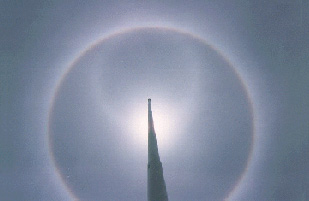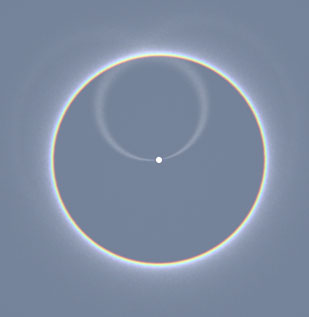
OPOD
What's New
Rays & Shadows
Water Droplets
Rainbows
Ice Halos
Contents
Crystals
Frequent Halos
22° circular
Sundogs
Tangent Arcs
Circumscribed
Solar altitude
Image Index
79º sun
Pillars
Circumzenithal
Circumhorizon
Parhelic Circle
Infrequent Halos
Multiple Displays
Other Worlds
Observing Halos
HaloSim
High Atmosphere
Links & Resources
Search - Index
123456789012345678
| Circumscribed Halo? |
 |
|
 |
Halos at the European Southern Observatory, La Silla Chile. Image ©Damien Hutsemekers, shown with permission.
The larger ring is probably a circumscribed halo, imperceptibly differing from a circle when, as here, the sun is very high. The smaller ring through the sun and touching the larger is the parhelic circle still centered about the zenith but shrunk down to a mere 11º radius. The photographer, Damien Hutsemekers, caught the sun at the just the required altitude of 79º in January 1990 for the halos to touch.
A single variety of ice crystals, horizontal columns, could have produced the display as in the lower HaloSim simulation. Light passing through side faces makes a circumscribed halo. Light reflecting (efficiently because of the near glancing incidence) off their nearly perpendicular end faces produces a parhelic circle.
But what is the faint halo outside the circumscribed halo and touching it at top and bottom? This is the high solar altitude form of the Wegener arc which has the same ray paths as the circumscribed halo except that light is internally reflected from a crystal end face. Very strong enhancement of Hutsemekers' image perhaps shows hints of the arc but it is hard to be sure.
Another explanation is that the halos are a 22º halo produced by poorly oriented crystals and a parhelic circle from plate crystals. There is not enough evidence to decide between these alternatives.